Environmental Economics Notes 12th Economics
12th Economics Lesson 8 Notes in English
8. Environmental Economics
“Environmental problems are really social problems…They begin with the people as the cause and end with people as victims”. –Sir Edmund Hillary
Introduction
- Environmental economics (EE) is the study of interactions between human economic activity and the natural environment. EE is the subset of economics that is concerned with the efficient allocation of environmental resources.
- The environment provides both a direct value as well as raw material intended for economic activity, thus making the environment and the economy interdependent.
- EE takes into consideration issues such as the conservation and valuation of natural resources, pollution control, waste management and recycling.
- Since resources – whether human, natural, or monetary –are finite, these public policies are most effective only when they achieve the maximum possible benefit in the most efficient way. The key objective of EE is to identify those particular tools or policy alternatives that will move the market towards the most efficient allocation of natural resources.
Meaning of Environment
- The term environment has been derived from a French word “Environia” means to surround. Environment means “all the conditions, circumstances, and influences surrounding and affecting the development of an organism or group of organisms”.
- It also means that the complex of physical, chemical and biotic factors that act upon an organism or an ecological community ultimately determine its form and survival.
Meaning of Environmental Economics
- It is a different branch of economics that recognizes the value of both the environment and economic activity and makes choices based on those values.
- The goal is to balance the economic activity and the environmental impacts by taking into account all the costs and benefits.
- In short, Environmental Economics is an area of economics that studies the financial impact of environmental issues and policies.
- Environmental Economics involves theoretical and empirical studies of the economic effects of national or local environmental policies around the world.
Eco System
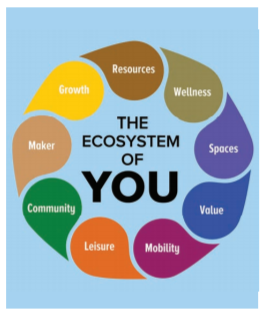
- An ecosystem includes all living things (plants, animals and organisms) in a given area, interacting with each other, and also with their non-living environments (weather, earth, sun, soil, climate, atmosphere).
- Ecosystems are the foundations of the Biosphere and they determine the health of the entire earth system.
Linkage between Economy and Environment
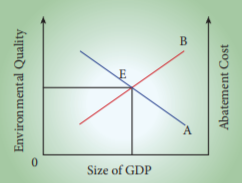
- Man’s life is interconnected with various other living and non-living things. The life also depends on social, political, ethical, philosophical and other aspects of economic system. In fact, the life of human beings is shaped by his living environment.
- The relationship between the economy and the environment is generally explained in the form of a “Material Balance Model’’ developed by Alen Kneese and R.V. Ayres. The model considers the total economic process as a physically balanced flow between inputs and outputs.
- Inputs are bestowed with physical property of energy which is received from the environment. The first law of thermodynamics, i.e. the law of conservation of matter and energy, emphasizes that in any production system “what goes in must come out”. This is known as the Material Balance Approach or Material Balance Principle.
- The material flow diagram implies that mass inputs must equal mass outputs for every process.
- Moreover, all resources extracted from the environment eventually become unwanted wastes and pollutants. Production of output by firms from inputs resulting in discharge of solid, liquid and gaseous wastes.
- Similarly, waste results from consumption activities by households. In short, material and energy are drawn from environment, used for production and consumption activities and returned back to the environment as wastes.
- In its simple form the Material Balance Approach can be put in form equation. Environment is the supplier of all forms of resources like renewable and non-renewable, and it is also acting as a sink for cleaning up of wastes.
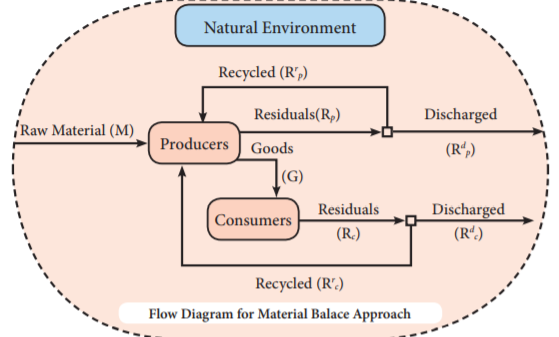
- Households and firms are connected to environment, and they are interconnected too. Households and firms depend on nature for resources.
- Both households and firms send out residuals of consumption and production respectively to nature. Nature has the power to assimilate all forms of waste. But this power is conditional.
- There is a limit for everything. The earth has reached the saturation point and it is unable to cleanup several forms of wastes. Remember, the earth can also non-cooperate!
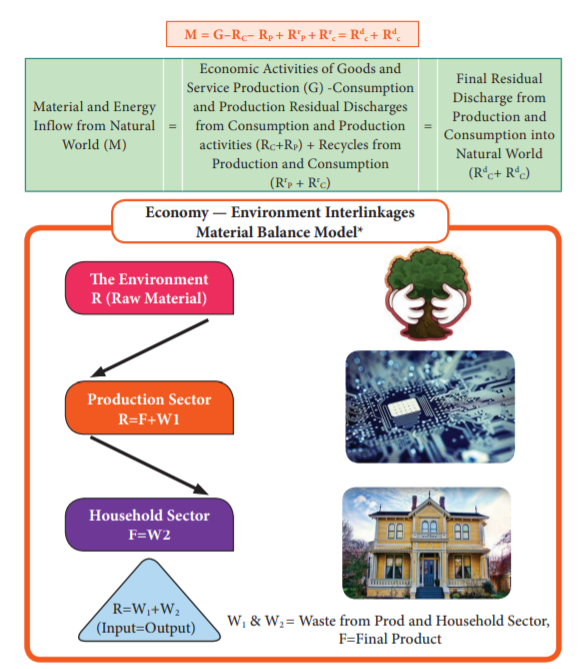
Environmental Goods
- Environmental goods are typically non-market goods, including clear air, clean water, landscape, green transport infrastructure (footpaths, cycle ways, greenways, etc.), public parks, urban parks, rivers, mountains, forests, and beaches.
- Concerns with environmental goods focus on the effects that the exploitation of ecological systems have on the economy, the well-being of humans and other species, and on the environment.
Environmental Quality
- Environmental quality is a set of properties and characteristics of the environment either generalized or local, as they impinge on human beings and other organisms.
- It is a measure of the condition of an environment relative to the requirements of one or more species and to any human need.
- Environmental quality has been continuously declining due to capitalistic mode of functioning. Environment is a pure public good that can be consumed simultaneously by everyone and from which no one can be excluded.
- A pure public good is one for which consumption is non-revival and from which it is impossible to exclude a consumer.
- Pure public goods pose a free rider problem. As a result, resources are depleted.
- The contribution of the nature to GDP as well as depletion of natural resources are not accounted in the present system of National Income Enumeration.
Externalities and the environment
Introduction
- In Environmental Economics, one of the most important market failures is caused by negative externalities arising from production and consumption of goods and services.
- Externalities are third party effects arising from production and consumption of goods and services for which no appropriate compensation is paid.
- Externalities occur outside of the market i.e. they affect people not directly involved in the production and consumption of a good or service. They are also known as spill-over effects.
Meaning of Externalities
- Externalities refer to external effects or spillover effects resulting from the act of production or consumption on the third parties.
- Externalities arise due to interdependence between economic units.
Definitions
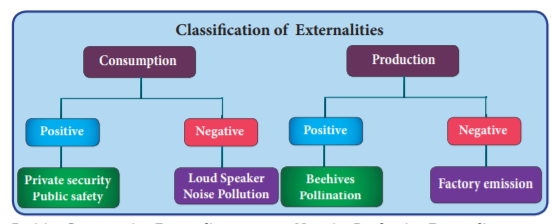
- Externality may be defined as “the cost or benefit imposed by the consumption and production activities of the individuals on the rest of the society not directly involved in these activity and towards which no payment is made”.
- The externalities arise from both production and consumption activities and their impact could be beneficial or adverse.
- Beneficial externalities are called “positive externalities” and adverse ones are called “negative externalities”.
Positive Consumption Externality
When some residents of a locality hire a private security agency to patrol their area, the other residents of the area also benefit from better security without bearing cost.
Negative Consumption Externality
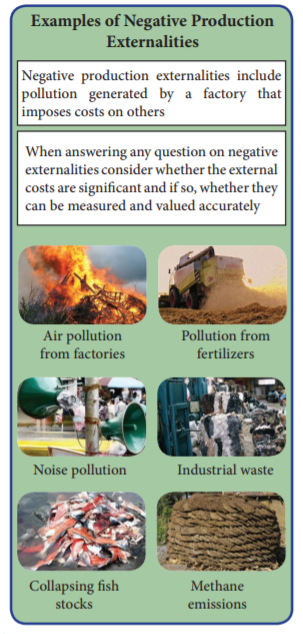
A person smoking cigarette gets may gives satisfaction to that person, but this act causes hardship (dissatisfaction) to the non-smokers who are driven to passive smoking.
Positive Production Externality
- The ideal location for beehives is orchards (first growing fields). While bees make honey, they also help in the pollination of apple blossoms.
- The benefits accrue to both producers (honey as well as apple). This is called ‘reciprocal untraded interdependency.
- Suppose training is given for the workers in a company. If those trained workers leave the company to join some other company, the later company gets the benefit of skilled workers without incurring the cost of training.
Negative Production Externality
The emissions and effluents of a factory cause air and water pollution. Water becomes contaminated and unfit for drinking e.g. Tanneries. The innocent community bears the external cost for which it is not compensated.
Pollution
Meaning
- Pollution is the introduction of contaminants into the natural environment that causes adverse change, in the form of killing of life, toxicity of environment, damage to ecosystem and aesthetics of our surrounding.
Types of Pollution
1. Air pollution
2. Water pollution
3. Noise pollution
4. Land pollution
Air Pollution
Definition
“Air pollution is the presence of any solid, liquid, or gaseous substance in the atmosphere in such concentration as may be or tend to be injurious to human beings or other living creatures or plants or property or environment”. –The Air (Prevention and Control of Pollution) Act, 1981
Types of Air pollution
Indoor Air Pollution:
It refers to toxic contaminants that we encounter in our daily lives in our homes, schools and workplaces. For example, cooking and heating with solid fuels on open fires or traditional stoves results in high levels of indoor air pollution.
Outdoor Air Pollution:
It refers to ambient air. The common sources of outdoor air pollution are caused by combustion processes from motor vehicles, solid fuel burning and industry.
Causes of Air Pollution
1. Vehicle exhaust smoke:
Vehicles smoke happens to release high amounts of Carbon monoxide. Millions of vehicles are operated every day in cities, each one leaving behind its own carbon footprint on the environment.
2. Fossil fuel based power plants:
Fossil fuels also present a wider scale problem when they are burned for energy in power plants. Chemicals like sulfur dioxide are released during the burning process, which travel straight into the atmosphere. These types of pollutants react with water molecules to yield something known as acid rain.
3. Exhaust from Industrial Plants and Factories:
Heavy machineries located inside big factories and industrial plants also emit pollutants into the air.
4. Construction and Agricultural activities:
Potential impacts arising from the construction debris would include dust particles and gaseous emissions from the construction sites. Likewise, using of ammonia for agriculture is a frequent byproduct that happens to be one of the most dangerous gases affecting air.
5. Natural Causes:
Earth is one of the biggest polluters itself, through volcanoes, forest fires, and dust storms. They are nature-borne events that dump massive amounts of air pollution into the atmosphere.
6. Household activities:
Household activities like cooking, heating and lighting, use of various forms of mosquito repellents, pesticides and chemicals for cleaning at home and use of artificial fragrances are some of the sources that contribute to air pollution.
Effects of Air Pollution
1. Respiratory and heart problems:
It creates several respiratory and heart ailments along with cancer. Children are highly vulnerable and exposed to air pollutants and commonly suffer from pneumonia and asthma.
2. Global warming:
Increasing temperature in the atmosphere leads to global warming and thereby to increase sea level rise and melting of polar icebergs, displacement and loss of habitat.
3. Acid rain:
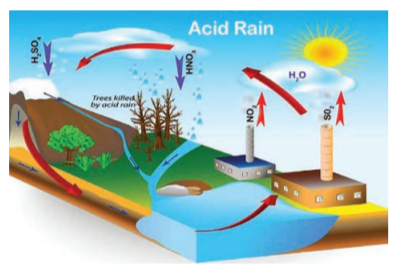
Harmful gases like nitrogen oxides and sulfur oxides are released into the atmosphere during the burning of fossil fuels. Acid rain causes great damage to human beings, animals and crops.
4. Eutrophication:
Eutrophication is a condition where high amount of nitrogen present in some pollutants which adversely affects fish, plants and animal species.
5. Effect on Wildlife:
Toxic chemical present in the air can force wildlife species to move to new place and change their habitat.
6. Depletion of Ozone layer:
Ozone exists in earth’s atmosphere and is responsible for protecting humans from harmful ultraviolet (UV) rays. Earth’s ozone layer is depleting due to presence of chlorofluorocarbons and hydro chlorofluorocarbons in the atmosphere.
7. Human Health:
Outdoor air pollution is a major cause of death and disease globally. The health effects range from increased hospital admissions and emergency room visits, to increased risk of premature death. An estimated 4.2 billion premature deaths globally are linked to ambient air pollution.
Remedial measures to control Air Pollution
1. Establishment of industries away from the towns and cities
2. Increasing the length of the Chimneys in industries
3. Growing more plants and trees
4. Use of non-conventional fuels like Biogas, CNG and LPG.
5. Use of Mass Transit System (Public Transport)
Water Pollution
Definition
“The introduction (directly or indirectly) of substances or energy into the marine environment (including estuaries) results in deleterious effects to living resources, hazards to human health, hindrance to marine activities. – United Nations, 1971
Types of Water Pollution
i. Surface water pollution:
Surface water includes natural water found on the earth’s surface, like rivers, lakes, lagoons and oceans. Hazardous substances coming into contact with this surface water, dissolving or mixing physically with the water can be called surface water pollution.
ii. Groundwater pollution:
Groundwater contamination occurs when manmade products such as gasoline, oil and chemicals get into the ground water. In addition, untreated waste from septic tanks, toxic chemicals from underground storage tanks and leaky landfills contaminate groundwater.
iii. Microbiological pollution:
In many communities around the world, people drink untreated water (straight from a pond,river or stream). Sometimes there is natural pollution caused by micro-organism like viruses and bacteria. This natural pollution causes both aquatic and human illness.
iv. Oxygen depletion pollution:
When oxygen levels in the water are depleted, relatively harmless aerobic micro-organisms die and anaerobic micro-organisms begin to thrive. Some anaerobic micro-organisms are harmful to people, animals and the environment as they produce harmful toxins such as ammonia and sulfides.
Causes of Water Pollution
Water pollution is caused due to several reasons. Here are the few major causes of water pollution:
1. Discharge of sewage and waste water:
Sewage, garbage and liquid waste of households, agricultural runoff and effluents from factories are discharged into lakes and rivers. These wastes contain harmful chemicals and toxins which make the water poisonous for aquatic animals and plants.
2. Dumping of solid wastes:
The dumping of solid wastes and litters in water bodies cause huge problems.
3. Discharge of industrial sastes:
Industrial waste contains pollutants like asbestos, lead, mercury, grease oil and petrochemicals, which are extremely harmful to both people and environment.
4. Oil Spill:
Sea water gets polluted due to oil spilled from ships and tankers while travelling. The spilled oil does not dissolve in water and forms a thick sludge polluting the water.
5. Acid rain:
Acid rain is pollution of water caused by air pollution. When the acidic particles caused by air pollution in the atmosphere mix with water vapor, it results in acid rain.
6. Global warming:
Due to global warming, there is an increase in water temperature as a result aquatic plants and animals are affected.
7. Eutrophication:
Eutrophication is an increased level of nutrients in water bodies. This results in bloom of algae in water. It also depletes the oxygen in water which negatively affects fish and other aquatic animal population.
Effects of Water Pollution
- Water pollution adversely affects the health and life of man, animals and plants alike. Polluted water is also harmful for agriculture as it adversely affects the crops and the soil fertility. Pollution of sea water damages the oceanic life.
- The effects can be catastrophic, depending on the kind of chemicals, concentrations of the pollutants.
- The effects of water pollution are varied and depend on what chemicals are dumped and in which locations. Many water bodies near urban areas are highly polluted.
- This is the result of both garbage dumped by individuals and dangerous chemicals legally or illegally dumped by manufacturing industries, health centers and markets.
i. Death of aquatic animals:
The main problem caused by water pollution is that it kills organisms that depend on these water bodies. Dead fish, crabs, birds and sea gulls, dolphins, and many other animals often wind up on beaches, killed by pollutants in their habitat.
ii. Disruption of food-chains:
Pollution disrupts the natural food chain as well. Pollutants such as lead and cadmium are eaten by tiny animals. Later, these animals are consumed by fish and the food chain continues disrupted at all higher levels.
iii. Diseases:
The discharge of untreated and under-treated effluent contributes to severe ecological degradation. The indiscriminate human activities such as open defecation, solid waste dumping, discharge of drainage water are responsible for the pathogenic bacteria water-borne diseases
like Hepatitis-A, Typhoid, Malaria, Dysentery, Jaundice, Dengue fever, Viral fever and Worm infections.
iv. Destruction of Ecosystems:
Ecosystems can be severely destroyed by water pollution. Many areas are now being affected by careless human pollution, and this pollution is coming back to hurt humans in many ways.
Remedial measures to control Water Pollution
1. Comprehensive water management plan.
2. Construction of proper storm drains and settling ponds.
3. Maintenance of drain line.
4. Effluent and sewage treatment plant.
5. Regular monitoring of water and waste water.
6. Stringent actions towards illegal dumping of waste into the water bodies.
Noise Pollution
Definition
Noise pollution is unwanted or excessive sound that can have deleterious effects on human health and environmental quality. Noise pollution is commonly generated by many factories. It also comes from highway, railway and airplane traffic and from outdoor construction activities. -Jerry A. Nathanson and Richard E. Berg, 2018
Types of Noise Pollution
i. Atmospheric Noise:
Atmospheric noise or static is caused by lighting discharges in thunderstorms and other natural electrical disturbances occurring in the atmosphere.
ii. Industrial Noise:
Industrial noise refers to noise that is created in the factories. Sound becomes noise it becomes unwanted. Heavy industries like ship building, iron and steel have long been associated with Noise Induced Hearing Loss (NIHL).
iii. Man made Noise:
The main sources of man-made noise pollution are ships, aircraft, seismic exploration, marine construction, drilling and motor boats.
Causes of Noise Pollution
i. Poor urban planning:
Improper urban planning will cause more nuisances among the city travelers.
ii. Sounds from motor vehicles:
Sounds from motor vehicles can cause temporary hearing loss.
iii. Crackers:
Enormous Crackers are used during some occasions. Such activities create a very louder noise to the level of harming the public. Sometimes, they may even cause deafness to children and aged.
iv. Factory machinery:
The industrial noise caused by continuous operation of mills, machines and pneumatic drills, is unbearable nuisance to the workers.
Effects of Noise Pollution
a. Hearing Loss:
Chronic exposure to noise may cause noise-induced hearing loss. Older people are exposed to significant occupational noise and thereby reduced hearing sensitivity.
b. Damage Physiological and Psychological health:
Unwanted noise can damage physiological and psychological health. For example, annoyance and aggression, hypertension, and high stress levels.
c. Cardiovascular effects:
High noise levels can contribute to cardiovascular problems and exposure to blood pressure.
d. Detrimental effect on animals and aquatic life:
Noise can have a detrimental effect on animals, increasing the risk of death.
e. Effects on wildlife and aquatic animals:
It creates hormone imbalance, chronic stress, panic and escape behavior and injury.
Remedial measures to control Noise Pollution
1. Use of noise barriers
2. Newer roadway for surface transport
3. Traffic control
4. Regulating times for heavy vehicles
5. Installations of noise barriers in the work place
6. Regulation of Loudspeakers
Land Pollution Definition
The land pollution is defined as, “the degradation of land because of the disposal of waste on the land”. Any substance (solid, liquid or gaseous) that is discharged, emitted or deposited in the environment in such a way that it alters the environment causes land pollution –Protection of the Environment Operations Act 1997
Types of Land Pollution
i. Solid waste:
It includes all kinds of rubbish like paper, plastic containers, bottles, cans, food, used cars, broken electronic goods, municipal waste and hospital waste.
ii. Pesticides and Fertilizers:
Many farming activities engage in the application of fertilizers, pesticides and insecticides for higher crop yield which pollute land.
iii. Deforestation:
Humans depend on trees for many things including life. Trees absorb carbon dioxide from the air and release Oxygen, which is needed for life. Forest helps replenish soils and help retain nutrients being washed away. Deforestation is led to land pollution.
Causes of Land Pollution
i. Deforestation and soil erosion:
Deforestation carried out to create dry lands is one of the major concerns. Land that is once converted into a dry or barren land, can never be made fertile again, whatever the magnitude of measures to convert it.
ii. Agricultural activities:
With growing human and pet animal population, demand for food has increased considerably. Farmers often use highly toxic fertilizers and pesticides to get rid off insects, fungi and bacteria from their crops. However the overuse of these chemicals, results in contamination and poisoning of land.
iii. Mining activities:
During extraction and mining activities, several land spaces are created beneath the surface.
iv. Landfills:
Each household produces tones of garbage each year due to changing economic lifestyle of the people. Garbage like plastic, paper, cloth, wood and hospital waste get accumulated. Items that cannot be recycled become a part of the landfills that cause land pollution.
v. Industrialization:
Due to increasing consumerism more industries were developed which led to deforestation. Research and development paved the way for modern fertilizers and chemicals that were highly toxic and led to soil contamination.
vi. Construction activities:
Due to urbanization, large amount of construction activities are taking place. This has resulted in large waste articles like wood, metal, bricks, plastic. These are dumped at the outskirts of urban areas that lead to land pollution.
vii. Nuclear waste:
The leftover radioactive materials, harmful and toxic chemicals affect human health. They are dumped beneath the earth to avoid any casualty.
Effects of Land Pollution
1. Soil pollution:
Soil pollution is another form of land pollution, where the upper layer of the soil is damaged. This is caused by the overuse of chemical fertilizers, and pesticides. This leads to loss of fertile land. Pesticides kill not only pests and also human beings.
2. Health Impact:
The land when contaminated with toxic chemicals and pesticides lead to problem of skin cancer and human respiratory system. The toxic chemicals can reach our body through foods and vegetables.
3. Cause for Air pollution:
Landfills and waste dumping lead to air pollution. The abnormal toxic substances spread in the atmosphere cause transmit respiratory diseases among the masses.
4. Effect on wildlife:
The animal kingdom has suffered mostly in the past decades. They face a serious threat with regards to loss of habitat and natural environment. The constant human activity on land is leaving it polluted, forcing these species to move farther away. Sometimes several species are pushed to the verge of extinction or disappear due to no conducive environment.
Remedial measures to control Land Pollution
1. Making people aware about the concept of a Reduce, Recycle and Reuse
2. Buying biodegradable products
3. Minimizing the usage of pesticides
4. Shifting cultivation
5. Disposing unwanted garbage properly either by burning or by burying under the soil.
6. Minimizing the usage of plastics.
Global Warming
- Global warming is the current increase in temperature of the Earth’s surface (both land and water) as well as its atmosphere. Average temperatures around the world have risen by 0.75ºC (1.4ºF) over the last 100 years.
- About two thirds of this increase has occurred since 1975.
- Carbon dioxide, methane, Chlorofluoro Carbon, nitrous oxides are the green house gases warming the earth’s surface. So it is also called green house effect.
- The CO2 is the most important of the green house gases contributing to 50% of global warming.
- The burning of fossil fuel, and other biomass, deforestation result in CO2. In the past, when the Earth experienced increases in temperature it was the result of natural causes but today it is being caused by human activities.
- Global warming adversely affects agriculture, horticulture and eco system. Reduced rainfall, higher temperature and increased pest/weed growth hamper farming.
- Threats to health arise due to increase in disease carrying vectors such as mosquitoes resulting in malaria, dengue fever, encephalitis and yellow fever.
- An increase in the global average surface air temperature of such magnitude will bring about alarming changes in rainfall patterns and other climatic conditions, resulting in serious ecological disequilibrium.
Climate Change
- The climate change refers to seasonal changes over a long period with respect to the growing accumulation of greenhouse gases in the atmosphere.
- Recent studies have shown that human activities since the beginning of the industrial revolution. have contributed to an increase in the concentration of carbon dioxide in the atmosphere by as much as 40%, from about 280 parts per million in the pre-industrial period, to 402 parts per million in 2016, which in turn has led to global warming.
- Several parts of the world have already experienced the warming of coastal waters, high temperatures, a marked change in rainfall patterns, and an increased intensity and frequency of storms.
- Sea levels and temperatures are expected to be rising.
Acid Rain
- Acid rain is one of the consequences of air pollution. It occurs when emissions from factories, cars or heating boilers contact with the water in the atmosphere.
- These emissions contain nitrogen oxides, sulphur dioxide and sulphur trioxide which when mixed with water becomes sulfurous acid, nitric acid and sulfuric acid.
- This process also occurs by nature through volcanic eruptions. It can have harmful effects on plants, aquatic animals and infrastructure.
e-Wastes
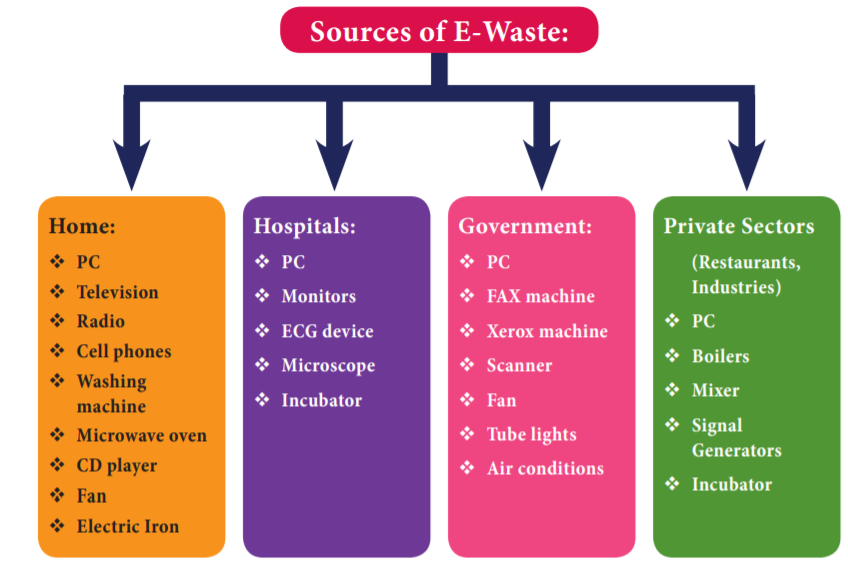
- Electronic waste which is commonly referred as “e-waste” is the new byproduct of the Info Tech society. It is a physical waste in the form of old discarded, end of life electronics.
- It includes a broad and growing range of electronic devices from large household appliances such as refrigerators, air conditioners, cellular phones, computers and other electronic goods“.
- Similarly, e-waste can be defined as the result when consumer, business and household devices are disposed or sent for re-cycling (example, television, computers, audio-equipments, VCR, DVD, telephone, Fax, Xerox machines, wireless devices, video games, other household electronic equipments).
Solid Waste
- Solid Waste is basically discharge of useless and unwarranted materials as a result of human activity.
- Most commonly, they are composed of solids, semisolids or liquids. Solid wastes consist of the discards of households, hospital refuse, dead animals, debris from construction site, ashes, agricultural wastes and industrial wastes etc.
- When waste is not removed from the streets and public places in time it poses severe public-health and hygiene hazards.
Sustainable Development
Meaning
- Sustainable development is concerned with the welfare of not only present generation but also future generation.
- It aims at not only satisfying the luxury wants of the upper class i.e. rich but also the basic necessities of the poor like food, sanitation, health care, education etc.
- The present generation should not exhaust the resources left by the past generation, but it should leave the same for the sake of future generation. This is called inter – generational equity.
Definitions
“Sustainable development is development that meets the needs of the present without compromising the ability of future generations to meet their own needs” -World Commission on Environment and Development, 1987- “The alternative approach (to sustainable development) is to focus on natural capital assets and suggest that they should not decline through time.” –Pearce, Markandya and Barbier, 1989-
Sustainable Development Goals (SDGs)
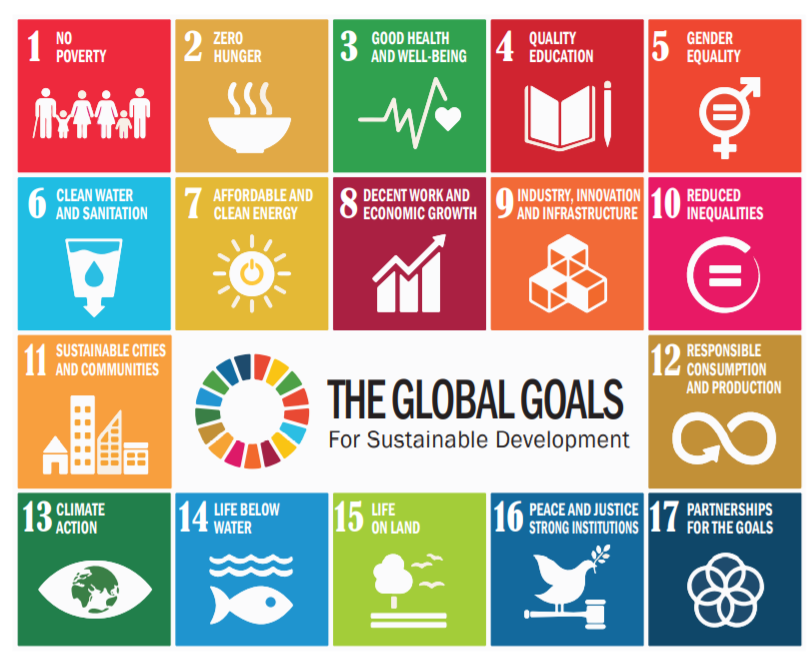
It is crucial to harmonize three core elements such as economic growth, social inclusion and environmental protection. A set of 17 goals for the World’s future can be achieved before 2030 with three unanimous principles fixed by United Nations such as Universality, Integration and Transformation.
1. End Poverty in all its forms everywhere
2. End hunger, achieve food security and improved nutrition and promote sustainable agriculture
3. Ensure healthy lives and promote wellbeing for all at all ages
4. Ensure inclusive and quality education for all and promote lifelong learning
5. Achieve gender equality and empower women and girls
6. Ensure access to water and sanitation for all
7. Ensure access to affordable, reliable, sustainable and modern energy for all
8. Promote inclusive and sustainable economic growth, employment and decent work for all
9. Build resilient infrastructure, promote sustainable industrialization and foster innovation.
10. Reduce inequality within and among countries
11. Make cities inclusive, safe, resilient and sustainable
12. Ensure sustainable consumption and production pattern
13. Take urgent action to combat climate change and its impacts
14. Conserve and sustainably use the oceans, seas and marine resources
15. Sustainably manage forests, combat desertifi cation, halt and reverse land degradation, halt biodiversity loss
16. Promote just, peaceful and inclusive societies
17. Revitalize the global partnership for sustainable development
Green Initiatives
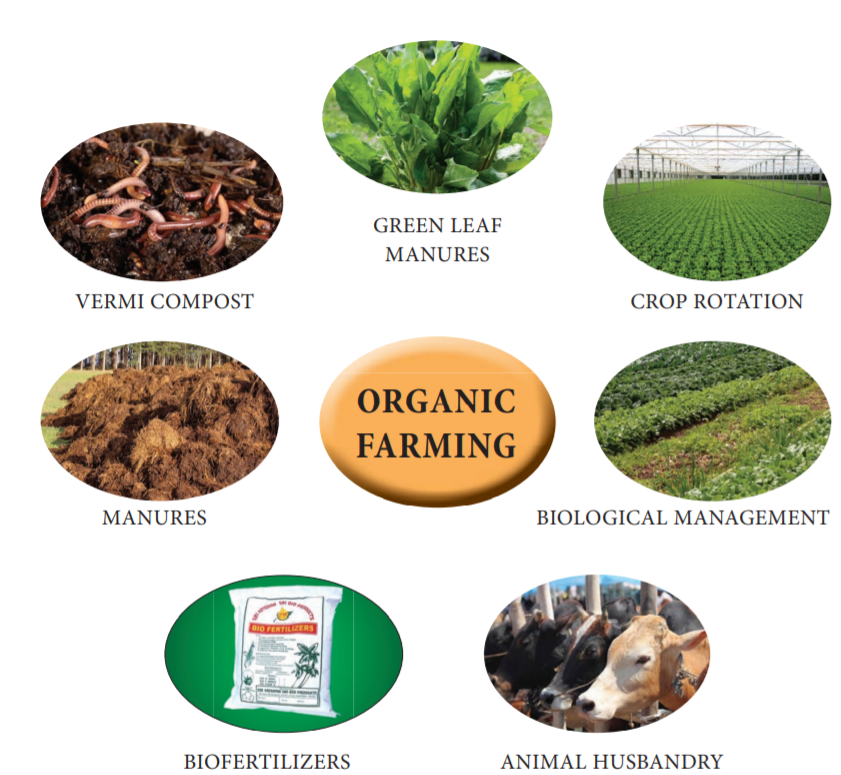
- Today, number of organizations, businesses and people across the globe that are striving for sustainability and more eco-friendly lifestyles is increasing.
- They are passionate towards protecting the Earth – the only life support system we have.
- Hence, we should bring about change through political lobbying, citizen action and consumer pressure.
- And we should take peaceful direct action to protect this fragile planet and promote the solutions for a green and peaceful future. Since the globe warming is a globe problem, the polluters, namely developed countries, should be made to pay for the pollution control efforts.
Organic Farming
- Organic farming is a system of agricultural production which relies on animal manure, organic waste, crop rotation, legumes and biological pest control. It avoids use of synthetic fertilizer, pesticides and livestock additives.
- Organic inputs have certain benefits, such as enriching soil for microbes.
- Organic production is a holistic system designed to optimize the productivity and fitness of diverse communities within the agro-ecosystem, including soil organisms, plants, livestock and people.
- The principal goal of organic production is to develop enterprises that are sustainable and harmonious with environment. The general principles of organic farming are:
1. Protect the environment, minimize soil degradation and erosion, decrease pollution, optimize biological productivity and promote a sound state of health.
2. Maintain long-term soil fertility by optimizing conditions for biological activity within the soil
3. Maintain biological diversity within the system
4. Recycle materials and resources to the greatest extent possible within the enterprise
5. Provide attentive care that promotes the health and meets the behavioural needs of livestock
6. Prepare organic products, emphasizing careful processing, and handling methods in order to maintain the organic integrity and vital qualities of the products at all stages of production.
7. Rely on renewable resources in locally organized agricultural systems.
Tree Plantation
- Trees contribute to their environment by providing oxygen, improving air quality, climate amelioration, conserving water, preserving soil and supporting wildlife.
- During the process of photosynthesis, trees take in carbon dioxide and produce the oxygen we breathe.
- So trees are considered to be the lungs of the earth. Natural forests and tree plantations improve the water cycle in diminishing runoff and improving the replenishment of the water table.
Seed Ball
- A seed ball (or seed bomb) is a seed that has been wrapped in soil materials, usually a mixture of clay and compost, and then dried.
- Essentially, the seed is ‘pre-planted’ and can be sown by depositing the seed ball anywhere suitable for the species, keeping the seed safely until the proper germination window arises.
- Seed balls are an easy and sustainable way to cultivate plants that provide a larger window of time when the sowing can occur.
Summary
- The introductory part of this chapter deals with human activity and natural environment. The concept of environmental economics is the subset of economics that is concerned with the efficient allocation of environmental resources.
- Further, it discusses the linkage between economy and environment with the help of material balance model developed by Alen Kneese and R.V. Ayres.
- The second part is concerned with different type’s pollutions like air, water, noise and land pollution and its cause, effects and various reduction strategies.
- Again, it dealt with the important aspects of global warming, climate change, acid rain, e-waste and solid waste which are responsible for environmental degradation.
- Finally, it also reflects the importance of sustainable development and its goals which are striving to achieve through mass programs like green initiatives, organic farming, tree plantation, seed ball and alkali farming.
- However, today the problems are mounting in the form of industrial pollution, atmospheric emission, soil erosion and land degradation, deforestation and irreversible loss of biodiversity due to increasing greed of the rich people.
- The underlying cause of environmental degradation in countries like India is failure of market and institutions, a factor which has not been adequately focused on corrective actions. Also, pollutions are cross-border problems.
- Unless all the countries simultaneously attempt to overcome the problem, global warming cannot be stopped. The rich countries which have been the cause for global warming, should be brought in to pay for the damages caused by them.
More to Know:
1. Alkali Farming
- Nearly 50 percent of the irrigated land in the arid and semi-arid regions has some degree of soil salinization problems.
- The occurrence of accumulation of excess salt/ acid in the root zone, results in a partial or complete loss of soil productivity and such soil is defined as ‘Problem (alkali, saline & acid) Soils’ and exist mainly in arid and semi-arid regions.
- The alkali soils are predominantly located in the Indo-Gangetic plains encompassing States of Punjab, Haryana, Uttar Pradesh, Bihar and partly in States like, Chhattisgarh, Rajasthan, Andhra Pradesh, Gujarat, Maharashtra, Karnataka, Andhra Pradesh, Madhya Pradesh and Tamil Nadu
2. Every day about 93% of the world’s children under the age of 15 (1.8 billion children) breath polluted air that puts their health and development at serious risk – WHO.
